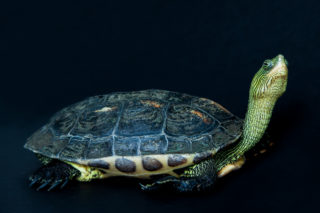Fun Facts
Air adaptation
Many river turtles can avoid the need to surface for air too often by using their bottom to absorb oxygen from the water. This is called cloacal respiration and is particularly important for some hibernating turtles, who spend the cold months underwater.
Basking in the sun
Like many reptiles, turtles do not generate much body heat. To get their body up to its best working temperature they often start their day by 'basking'. They will sit out in the sun and catch as much of its energy as they can.
Group life
Stripe-necked turtles are more social than many of the other species in their genus. Turtles usually prefer to be alone most of the time, and although they are not as interactive with each other as very social species like elephants, they will often bask in the same spots and tend to spend more time with other turtles.
Toothless
Turtles today do not have any teeth. Instead, they rely on sharp beaks and often sharp and even jagged jawbones to break up their food.
Drinking
As their nostrils are connected to their mouths, many turtles have taken to drinking water through their nose. This is common with many reptiles. Sometimes you might see a turtle stick its entire head into the water and drink without opening its mouth.

